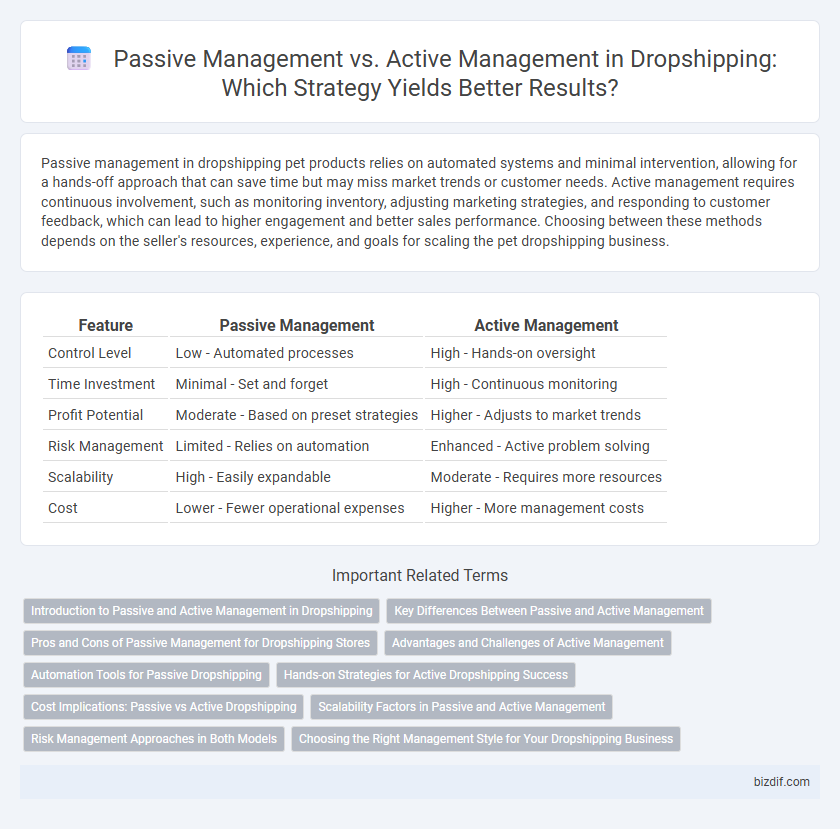Passive management in dropshipping pet products relies on automated systems and minimal intervention, allowing for a hands-off approach that can save time but may miss market trends or customer needs. Active management requires continuous involvement, such as monitoring inventory, adjusting marketing strategies, and responding to customer feedback, which can lead to higher engagement and better sales performance. Choosing between these methods depends on the seller's resources, experience, and goals for scaling the pet dropshipping business.
Table of Comparison
| Feature | Passive Management | Active Management |
|---|---|---|
| Control Level | Low - Automated processes | High - Hands-on oversight |
| Time Investment | Minimal - Set and forget | High - Continuous monitoring |
| Profit Potential | Moderate - Based on preset strategies | Higher - Adjusts to market trends |
| Risk Management | Limited - Relies on automation | Enhanced - Active problem solving |
| Scalability | High - Easily expandable | Moderate - Requires more resources |
| Cost | Lower - Fewer operational expenses | Higher - More management costs |
Introduction to Passive and Active Management in Dropshipping
Passive management in dropshipping involves automating order fulfillment and supplier communication to minimize daily oversight, leveraging tools like inventory sync and automated pricing updates. Active management requires continuous monitoring of market trends, customer feedback, and supplier performance to adjust product listings, marketing strategies, and inventory in real-time. Combining both approaches can optimize operational efficiency while maintaining responsiveness to market changes and customer demands.
Key Differences Between Passive and Active Management
Passive management in dropshipping involves automating product listing, inventory updates, and order fulfillment to minimize hands-on involvement, emphasizing efficiency and scalability. Active management requires continuous monitoring of supplier performance, pricing adjustments, customer service, and marketing strategies to adapt quickly to market trends and maximize profit margins. Key differences include the level of control, time investment, and responsiveness to market changes, with passive strategies relying on set systems and active strategies demanding ongoing engagement.
Pros and Cons of Passive Management for Dropshipping Stores
Passive management in dropshipping involves minimal daily oversight, allowing entrepreneurs to automate order processing and inventory updates through reliable suppliers and software. Pros include reduced time commitment, scalability, and the ability to generate steady income with lower stress levels. Cons involve slower response to market trends, potential quality control issues, and a higher risk of customer service delays impacting brand reputation.
Advantages and Challenges of Active Management
Active management in dropshipping offers advantages such as real-time inventory control, swift response to market trends, and personalized customer service, which can enhance brand reputation and increase sales. However, it poses challenges including higher time investment, the risk of operational errors due to constant adjustments, and the need for advanced analytics tools to monitor performance effectively. Balancing active oversight with scalability demands is crucial for maintaining profitability and customer satisfaction.
Automation Tools for Passive Dropshipping
Passive dropshipping relies heavily on automation tools like Oberlo, Spocket, and AutoDS to streamline product sourcing, order fulfillment, and inventory management, reducing manual intervention significantly. These platforms synchronize with e-commerce sites to automatically update stock levels and track shipments, enabling store owners to focus on marketing and customer service. Automation enhances efficiency in passive dropshipping by minimizing errors and operational workload compared to active management, which requires constant hands-on engagement.
Hands-on Strategies for Active Dropshipping Success
Active dropshipping management involves hands-on strategies such as real-time inventory monitoring, continuous market trend analysis, and proactive customer service to optimize sales and minimize errors. Employing dynamic pricing algorithms and targeted marketing campaigns ensures responsiveness to market demands and competitor actions. This approach contrasts with passive management by fostering higher engagement, quicker adaptation, and improved overall operational efficiency in the dropshipping business model.
Cost Implications: Passive vs Active Dropshipping
Passive dropshipping requires minimal ongoing involvement, reducing labor costs but potentially leading to slower response times and lower profit margins due to less frequent inventory updates. Active dropshipping demands continuous management, increasing operational expenses through staff wages and software tools, but enables better customer service and faster inventory turnover, often resulting in higher revenue. Evaluating cost implications involves balancing lower fixed costs of passive oversight against the dynamic, variable costs and potential profitability gains from active engagement in dropshipping operations.
Scalability Factors in Passive and Active Management
Passive management in dropshipping relies on automated processes and outsourced operations, limiting scalability due to reduced control over inventory and customer service. Active management demands hands-on involvement in marketing, supplier relations, and order fulfillment, enabling faster adaptation and expansion but requiring significant time and resource investment. Scalability in active management benefits from dynamic decision-making and personalized oversight, whereas passive strategies often plateau due to reliance on predefined systems and minimal intervention.
Risk Management Approaches in Both Models
In dropshipping, passive management minimizes hands-on oversight, relying heavily on automated systems and supplier reliability, which increases exposure to supply chain disruptions and quality control issues. Active management involves continuous monitoring and direct intervention in order fulfillment and customer service, significantly reducing risks related to delivery delays and product inconsistencies. Effective risk management in dropshipping hinges on balancing supplier vetting, inventory tracking, and responsive issue resolution aligned with the chosen management style.
Choosing the Right Management Style for Your Dropshipping Business
Choosing the right management style for your dropshipping business affects operational efficiency and profitability. Passive management relies on automated tools and supplier handling to minimize daily intervention, ideal for entrepreneurs balancing multiple ventures. Active management demands hands-on involvement in order fulfillment, customer service, and inventory control, providing greater control and ability to respond swiftly to market changes.
Passive Management vs Active Management Infographic

 bizdif.com
bizdif.com